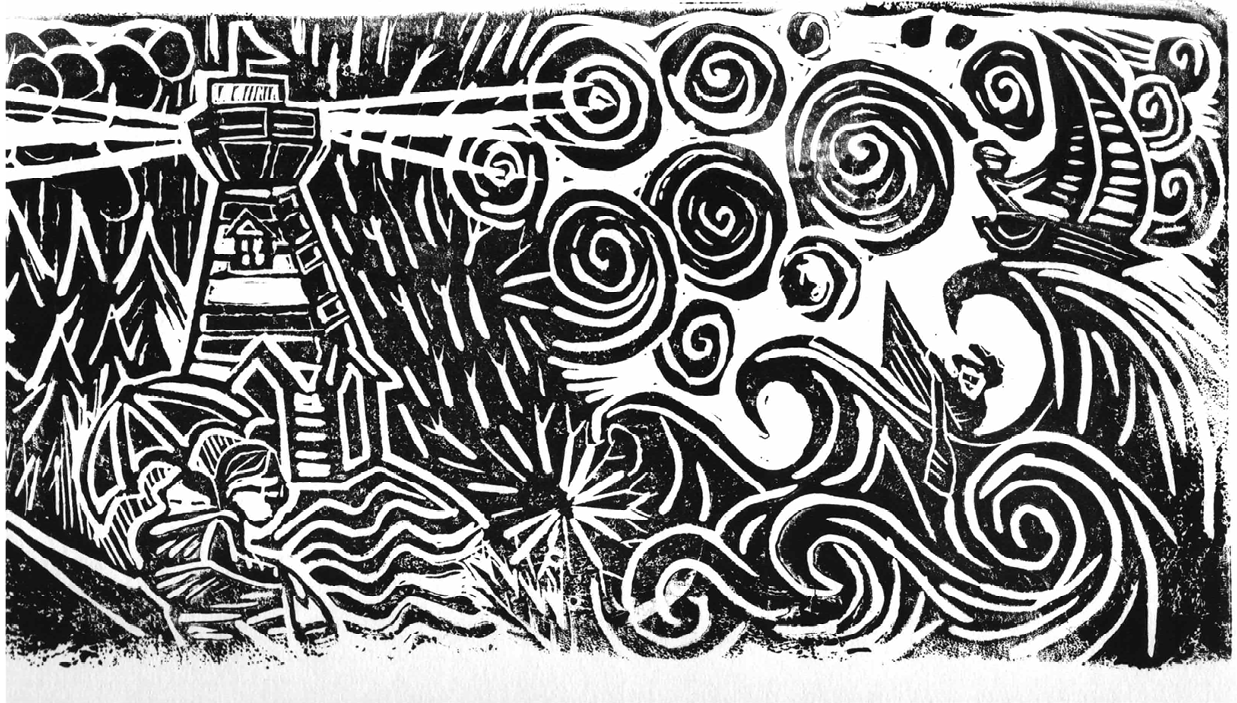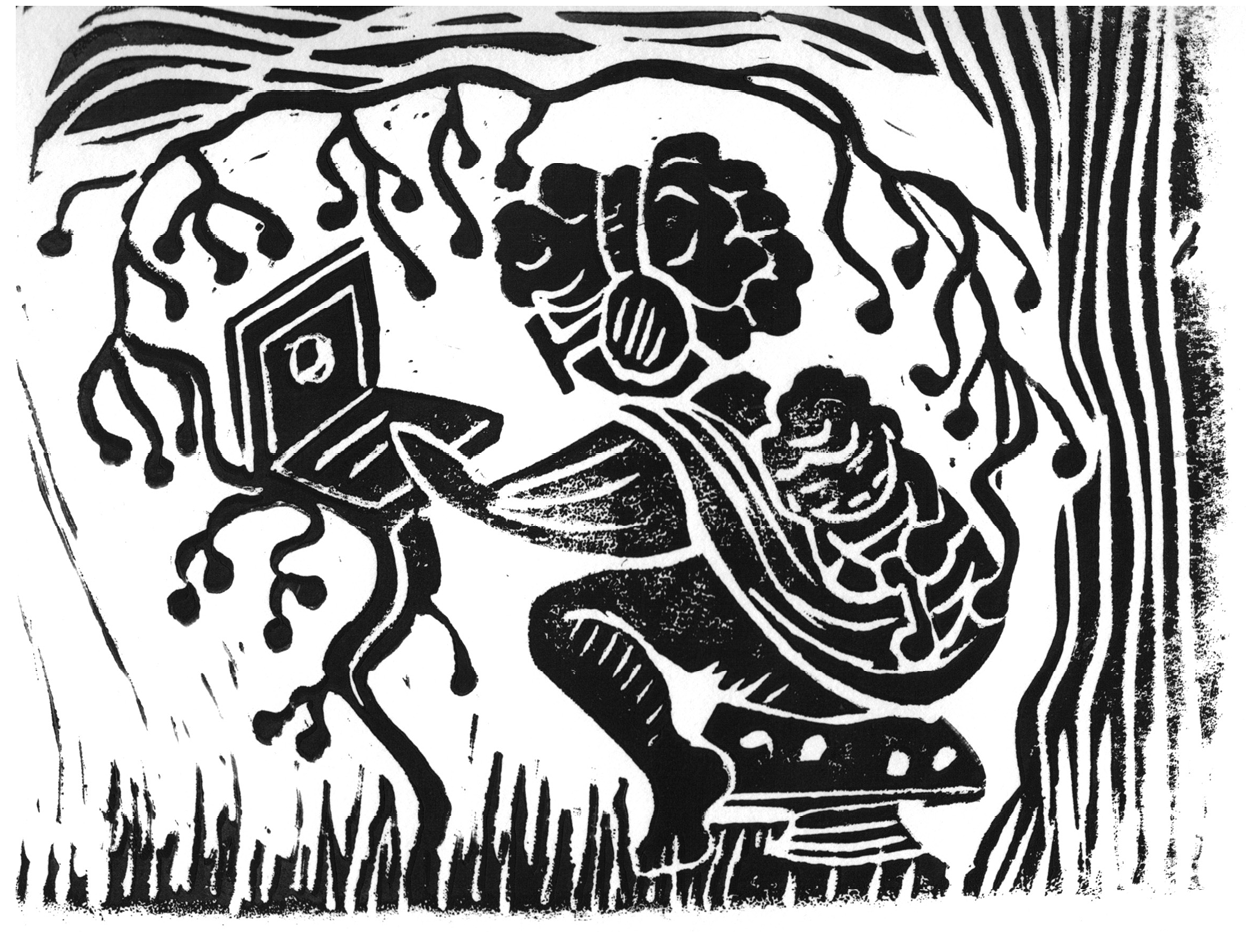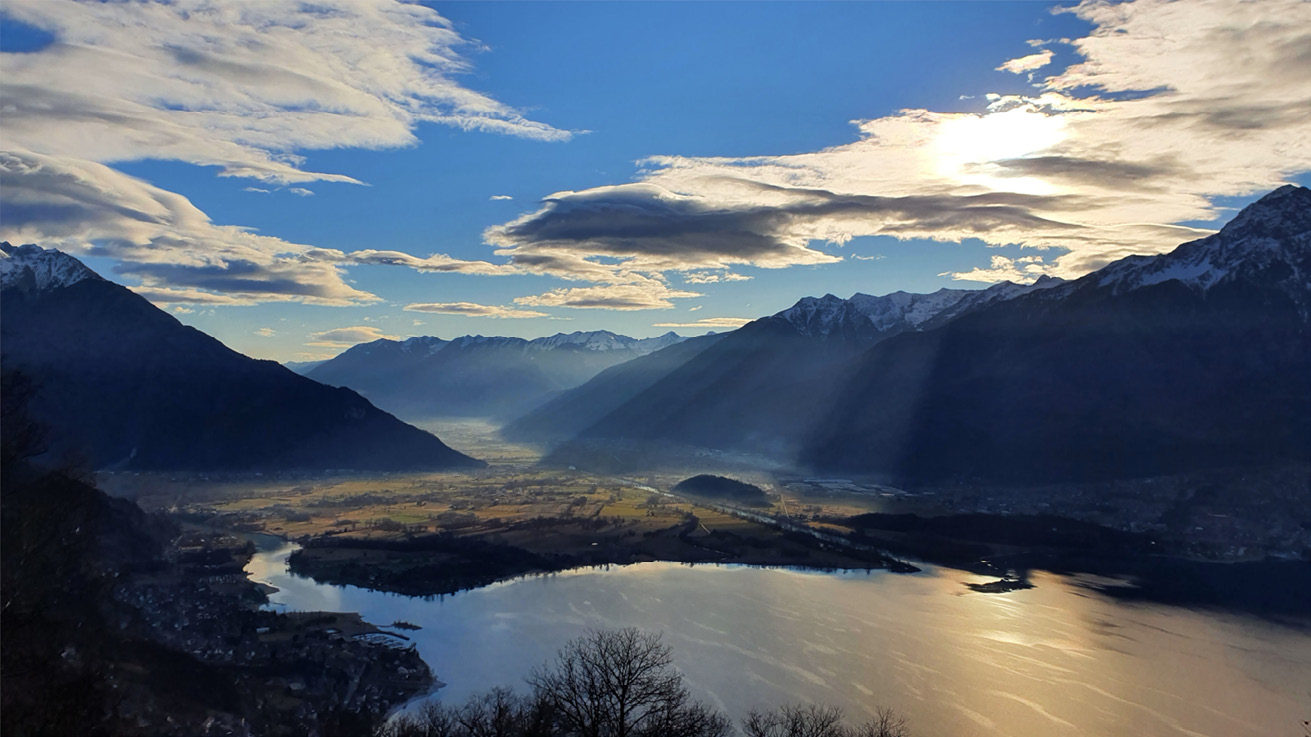Section III Considering Alternative Futures

‘Vessels of Hope’ by Giulia Forsythe (CC0)

‘Vessels of Hope’ by Giulia Forsythe (CC0)
Note from the artist
“It is the story that makes the difference” wrote Ursula Le Guin (1989, p. 168). Not the killer story of arrows, bombs, and destruction, but the life story of care and survival. The shape of the story is the sling for the child, the basket for gathering food, the vessel to carry water. HE4Good is a container to explore the “good” higher education can bring; it is the hope in a storm, the light beacon to guide towards safe harbour as successive waves of crises pummel the most vulnerable.
References:
Le Guin, U. K. (1989). The carrier bag theory of fiction. Ignota Books. (Original work published in 1986).
11. Calm in the storm
© 2023 Paola Corti and Chrissi Nerantzi, CC BY-NC 4.0 https://doi.org/10.11647/OBP.0363.11
Note for readers and suggestions for use
This chapter is in the form of a photograph, an audio podcast, and a transcript of the podcast, referenced at the end of the chapter. Paola and Chrissi speak in alternate turns in the podcast; this is noted in the transcript.
We propose that our contribution could be used as an alternative conversation trigger, in whole or in part. The use we make of both audio and written visual language offers alternative ways to uncover and discover novel connections. The format we have chosen is an open invitation to immerse the listener and/or reader with us and our thinking and to encourage conversation. Readers/listeners can use a range of metaphors from nature and the world around you to explore, discuss and debate challenging issues and opportunities with other educators and students. The metaphors can be linked to higher education experiences and practices to better understand what is important, to see the higher education landscape with fresh eyes, and to identify and embrace positive ways forward.
Introduction
Chrissi: Close your eyes.
Get comfortable.
And relax.
Take a deep breath in.
Release it.
Take another one.
Release it.
Now breathe normally.
Feel the air travelling through your whole body.
Now open your eyes.
Look at the photo in front of you. (Figure 11.1)
Figure 11.1
Valtellina valley, Italy. Photo by Paola Corti. https://pxhere.com/it/photo/1667214, CC0

What do you see?
Where are you in this landscape?
What paths do you see?
Look at the open areas.
And the steep mountains.
Look at the light and the darkness.
Where would you like to be in this landscape?
Teleport yourself there, into the picture.
How do you feel being in this landscape?
Is it a familiar space?
Is it in any way different from what you know?
What would you be in this landscape?
What will you bring with you?
How could you feel connected with everything that surrounds you?
Keep breathing naturally.
This place
Paola: In this photograph, the sun has just risen from behind a mountain on the right but is partially hidden behind beautiful white fluffy morning clouds. So, the light is not harming the eyes as it is not too direct. The effects of the sunlight on the surroundings are truly amazing: it highlights the profile of the mountains, it reaches the bottom of the valley, making fields shine, and it reflects on the waters of the river and the lake. You can see their beauty and their potential. All the elements of the landscape together make it beautiful. It’s a mixture of elements; none of them alone would create the same effect.
One of the details I love most is the light that changes according to the profile of the mountains: you see these lines in between light and shadow, and you can perceive the direction of the rays, but you don’t see them directly. You can’t touch it; you see its effect on the rest. As if the light, even if you can’t look at it in itself, can make everything else matter in your eyes.
This valley went through floods, avalanches, and landslides over time.
It is not only an image of calm, peace, and beauty.
The weather can change quite quickly and become stormy or windy. It can start raining at any moment. Also, the temperature might rise or fall at any time.
A long time ago, when the Romans arrived, they had built terracing to cultivate the sunniest side.
Historical, social, cultural, and natural events are coming together.
It can get incredibly hot in the summer and incredibly cold in the winter.
People there help each other to maintain the valley as it is, let it evolve naturally, and preserve it while living in it.
Some people are there day after day, all year; others come just for the weekend, for work or for fun, to relax or to reenergise.
Some of them cultivate the fields, and others have shops and offer services.
Some people climb, run, cycle, or simply enjoy exploring the surroundings.
To let this valley develop sustainably means balancing logistic solutions (like new roads to the skiing areas), with the needs of a territory that “holds together” with a precise — and sometimes fragile — balance.
Being respectful of this balance makes a real difference.
Chrissi: Now, you…
Where would you be in this landscape?
Would you choose to be on the peak of the mountain, climbing to the top with a lot of energy, and technical skills, engaging with your whole body, feeling the cold and the chill wind but proceeding notwithstanding all challenges? Would you be there as a mountain guide, taking care of others, or with your peers, caring for each other, or as a solitary climber?
Or do you see yourself in the plain, looking around you in a peaceful and restful moment, taking a pause while all other people around you are working in the field and you can observe them carefully, but just looking around?
Or maybe you could be in an Italian bar, along the street, starting your day with an espresso and getting ready to dive into work?
What about travelling from one side to the other?
Or sailing on the water, in a boat?
Or even swimming?
How does it feel being there?
What do you see nearby?
And in the distance?
What helps you feel calm?
Can you sense the excitement?
Where does it come from?
Considering higher education for good
Paola: The valley you see is called Valtellina, and it is in the Lombardy region, in the north of Italy, close to the Alps and the Swiss border. It runs from west to east. When I thought about higher education for Good (HE4Good from now on), I immediately went back to this particular photo. I have thousands of photos taken in the mountains. I immediately felt a great connection with the book’s theme, and I went looking for it. I talked with Chrissi about it, and we are here now, sharing with you why we feel like this landscape, as a whole and as a collection of small parts, possibilities, and activities instantly stopped in the shot, but relentlessly ongoing, can somehow represent the higher education landscape.
Imagine all forms of life in this valley. From the smallest insect, or bacterium, to the largest tree and herds of roe deer. Small and big animals, including humans, small blades of grass and centennial trees, diversity in its full glory represented and needed to keep the ecosystem balanced.
Imagine people living and working there. All facilities, services, spaces, and their use all change over time. The fastest and the slowest changes. Every day. Overtime. While the light — in this specific case, the sunlight — and the weather change continuously in a flow that experts can try to foresee but could not 100% guess.
Let’s think about HE4Good now.
As in this valley, in HE4Good, people can come and go. The entrance is open, and students of all ages move through it freely, taking opportunities to learn from others and from each other. Sometimes, they have to pay for specific services. Sometimes, they can be autonomous in picking what is available for free. They can also stay for a little bit longer. They can enjoy what HE4Good has to offer in terms of experience, knowledge, exchange with other people, explorations, and learning new skills. Moreover, they can contribute to all of it. They can make plans here, they can and have to take good care of what they touch, taste, use. Otherwise, the somehow fragile balance it relies on can fall apart and can consequently fail to maintain its offer as good as it is or become even better than it is now.
People living in the valleys are known to welcome those joining them for a while. Still, sometimes, they prefer them to return to where they came from, which resonates with the anti-immigration attitude of some countries and some universities. This is part of their idea of sustainability: the valley cannot physically host everyone, it has room for a certain amount of people, and that’s it. More than that would not be sustainable. With HE4Good, as expanded as it can be, with more people than ever before virtually studying at university and with online resources and open resources, practices, and communities available, there is potentially no limit to access in terms of sustainability. Even if we are not there yet at present and even if the required infrastructure needs to be sustainable too, in itself. There are still hurdles, significant hurdles, regarding making these precious learning opportunities accessible to all, and we mean all. Finding imaginative ways to embrace all humans and helping them grow and flourish is so important. In a similar way, the valleys are open and embracing.
What about making connections?
In the valley, as in HE4Good, covering distances and reaching out to the place or the people you are headed to is not always easy. It largely depends on the path you walk and how many mountains, rivers, and other challenges are in your way. Sometimes it’s a brand-new street, just renewed and recently enlarged, with good signals and linked to well-funded opportunities of political importance. Sometimes they are single tracks with steep climbs and descents, and some scary places to cross. But they have been built with care and commitment by people who see the need and want to contribute to creating passages for small groups of users, not necessarily for large numbers. These paths are less visible. Sometimes, they are very well indicated but not as mainstream as a highway. Some tracks are entirely new, nobody has gone there before, and they are a space of pure exploration, between risks and opportunities, and the agency is totally in the hands of the explorers. All are needed. All work to create access opportunities. All have to respect and preserve the others to keep the whole valley and the entire university sustainable.
Constantly keeping an eye on the needs of the other living beings involved in the valley, as in higher education, is fundamental to preserving the very existence of the whole ecosystem. Resources are limited in some areas, and they should be responsibly used with priorities agreed upon based on responsibility for the greater good. On the other hand, peer support and shared efforts can be key solutions to specific challenges through coordinated actions that can be beneficial for more than one issue at a time. In the valley, all the terraces on the sunny side both make it easier to grow vineyards and, at the same time, prevent avalanches from falling freely and violently to the bottom of the valley. Similarly, there are actions in HE4Good that can be beneficial for more than one stakeholder at a time. Consider open practices: an example where students, educators and researchers can build experiences together and produce outputs that serve different purposes while providing visibility to the institution. Sometimes these are also beneficial for citizens at large through the outcomes.
The river Adda flows through the valley and pours its water into Lake Como. The same happens in the academic context: stimulations, information and knowledge created and shared can flow outside the boundaries of the university and continuously, relentlessly get mixed into the civil society with other knowledge belonging to different contexts. No degrees of separation in the end. Through the water cycle, the mixed waters will return to the highest peaks and pour down in another form, like rain or snow, when the moment comes. This is nature’s circle, and we must be mindful of the harmful disruptions we may cause…
We are describing these ecosystems in parallel to help us see the value of different elements and their links. In HE4Good, we also see the power of virtuous examples, even when small and situated, contextual, as something that can be inspiring for others to act elsewhere, maybe with change to adapt them to a different context. Also, we see the beauty of handcrafted solutions where mainstream ones do not reach the same results, and sometimes, the power of scaling down and having more focused outputs instead of choosing one-size-fits-all solutions. Adaptation to specific needs is more valuable/more effective as a long-term strategic approach when looking at diversity as a rich opportunity to be preserved.
Before we reach the end and wrap up after reflecting out loud, let’s go back to the adjective in the acronym HE4Good: let’s talk about “good”. “Good” doesn’t necessarily mean pleasant or riskless or even reassuring, or stable. As it happens in the valley, work is needed, and things that seem to be stable are stable just for a little while or a bit longer. Risk is around the corner not only when you decide to climb. It can accompany you while you start your new activity on the plain! The same happens in higher education, with more visible projects or small or new activities that can make change happen from the ground up. Also, “good” can be restless, fatiguing, sometimes fearful, and somehow constantly changing even when not visible or evident.
But… aren’t change and learning viscerally linked to each other? “Good” embeds all these adjectives altogether. HE4Good relies on our attitude to embrace them all, deal with them, manage to go beyond their consequences and be mindful of others struggling with the same challenges together.
We would like to invite you to consider the following in reference to HE4Good:
- Be patient: the growth of a system is often very slow and not immediately visible. Commitment, persistence, and teamwork are key.
- What is sure, change happens all the time; it happens to you, as an individual, and as a member of a changing community; be ready.
- Remember, you will, at times, feel discomfort. It is OK; it’s part of change and learning.
- Be mindful that you are not alone: share resources, expertise, and spaces.
- Work with others… act together.
Moving forward
Chrissi: Now close your eyes again.
Breathe naturally.
Take a deep breath and focus on the landscape you were just in.
What do you remember?
If you could bottle something you found there, what would it be?
Think about it.
Which three things would you take with you?
Take them with you, in your bottle.
Now create your own landscape.
How does it look?
How does it feel?
What do you see?
Teleport yourself into your landscape.
Place yourself somewhere in your landscape that makes you feel energised… empowered.
What will you explore?
Where are your curiosity and imagination taking you?
What about the landscape around you?
Your companions?
How will you embrace otherness, hope and care?
Thank you for listening and for being willing to move forward.
Acknowledgments
We would like to thank (in chronological order): Professor Margy MacMillan, Valeria Baudo, Margherita Ferrario, Adam Frank, Dr Sadia Afroze Sultana, Marta Bustillo, Bianca Gregori, and our reviewers and editors for providing valuable feedback and suggestions for our chapter. It wouldn’t have been the same without their ideas and thoughts.
References
Corti, P. & Nerantzi, C. (Co-hosts). (2022, October 27). CALM IN THE STORM [Audio podcast.] #HE4Good. Google Drive.
https://drive.google.com/file/d/1UEPFL2_TithAr9FUBKGDJCCf Wi6TVncg/view?usp=sharing
